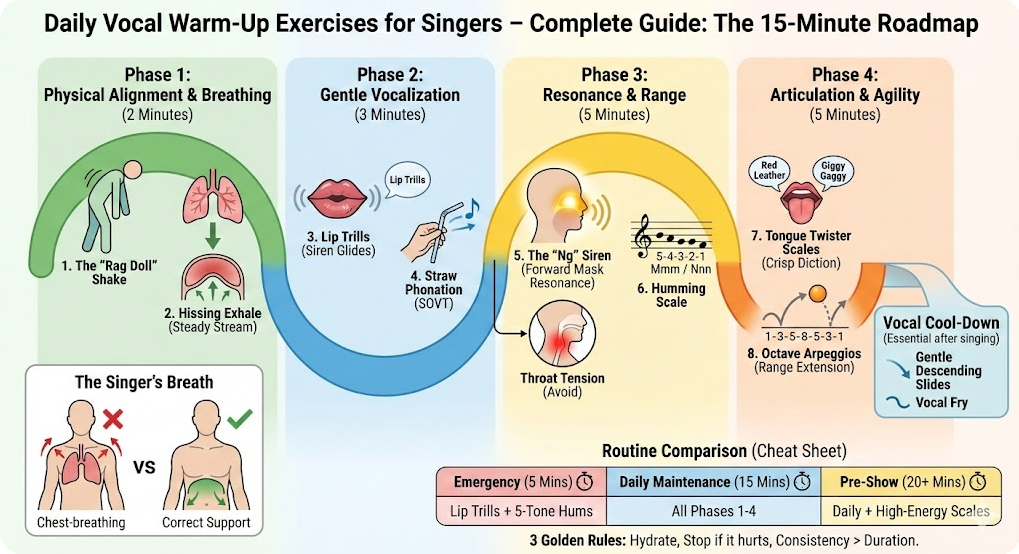A healthy, flexible, and powerful singing voice starts with daily vocal warm-ups. Whether you’re a beginner or a professional, warming up before singing prevents strain, improves tone, and builds vocal stamina over time.
In this guide, you’ll learn step-by-step warm-up routines, tips for improving your technique, and exercises for breath support, range, and vocal agility.
If you want to check your vocal range before you start practicing, try our free tool on the Vocal Range check to measure your lowest and highest notes.
Why Vocal Warm-Ups Are Essential
Warm-ups prepare your voice in three main ways:
- Physical Readiness: Relaxes throat muscles and vocal folds
- Breath Support: Builds control for long phrases and high notes
- Vocal Health: Prevents strain, cracking, and fatigue during singing
Singers who skip warm-ups risk vocal injuries and limited range over time.
How Long Should Warm-Ups Take?
- Beginners: 5–10 minutes per day
- Intermediate/Advanced Singers: 15–20 minutes before rehearsal or performance
Consistency matters more than intensity — short, regular practice is more effective than occasional long sessions.

Daily Vocal Warm-Up Routine (10–15 Minutes)
Here’s a simple, structured routine for all singers:
1. Breathing Exercises (2 minutes)
- Practice diaphragmatic breathing
- Inhale for 4 counts → Hold 4 counts → Exhale for 8 counts
- Improves breath support and control
For more detail, see our guide on breathing techniques for singing.
2. Lip Trills & Tongue Trills (2 minutes)
- Relax lips and blow air to create a “brrr” sound
- Glide up and down scales while trilling
- Builds airflow control and resonance
3. Humming on Scales (2 minutes)
- Hum lightly on a comfortable pitch
- Slide up and down a 5-note scale
- Focus on smooth airflow and resonance in the face
4. Sirens or “Woo” Glides (2 minutes)
- Start from low to high pitch smoothly like a siren
- Strengthens vocal range transitions
- Great for blending chest and head voice registers
If you struggle with register shifts, read chest voice vs head voice for blending tips.
5. Vowel Exercises on Scales (3 minutes)
- Sing “ah,” “ee,” “oo” vowels on ascending and descending scales
- Improves diction, clarity, and vocal agility
6. Light Song Practice (Optional)
- Sing a simple song after warm-ups
- Apply breathing and tone control techniques learned
Warm-Ups for Different Voice Types
| Voice Type | Suggested Warm-Up Focus |
|---|---|
| Soprano | High range sirens + vowel agility drills |
| Mezzo-Soprano | Mid-range resonance + breath control |
| Contralto | Low-range scales + sustained tones |
| Tenor | Mix voice transitions + high note drills |
| Baritone | Chest resonance + gradual range building |
| Bass | Low register strength + airflow exercises |
Main Interactive Tools:
- Vocal Range Test – find your exact highest and lowest notes online in seconds.
- Vocal Range Calculator – measure and record your range accurately using your microphone.
- Singer Comparison Tool – compare your vocal range with famous singers and see where you align.
- AI Voice Analysis – get instant feedback on your tone, pitch stability, and clarity through advanced AI.
- Song Key Finder – discover songs that naturally fit your vocal range and tessitura.
- Ear Training Game – improve pitch accuracy and interval recognition through fun listening challenges.
- Microphone Tester – check your mic setup before testing your range or recording vocals.
Tips for Effective Vocal Warm-Ups:
- Stay Hydrated: Drink room-temperature water before singing
- Maintain Good Posture: Keep shoulders relaxed, chest open
- Avoid Over-Singing: Gentle warm-ups prevent fatigue
- Be Consistent: Practice daily, even on non-performance days
For long-term care, see our guide on vocal health tips for singers.
Common Warm-Up Mistakes:
- Skipping breath exercises before singing
- Pushing high notes without proper range expansion
- Singing too loudly during warm-ups
- Neglecting lower registers for balanced tone
For safe high-note training, check expand vocal range safely for gradual methods.
Quick 5-Minute Warm-Up (For Busy Days)
- 1 min – Diaphragmatic breathing
- 1 min – Lip trills with scales
- 1 min – Humming up and down 5-note scales
- 1 min – Siren glides low → high → low
- 1 min – Vowel singing on “ah” and “ee”
Even short warm-ups protect your voice before speaking or singing.
Warm-Ups for Choirs and Groups:
- Unison Breathing Exercises → build timing and control
- Group Sirens → unify resonance and tone
- Staggered Breathing Practice → seamless sound during long phrases
Daily Routine Summary Table
| Exercise | Duration | Purpose |
|---|---|---|
| Diaphragmatic Breathing | 2 min | Breath support & control |
| Lip & Tongue Trills | 2 min | Airflow, resonance, agility |
| Humming on Scales | 2 min | Tone quality, resonance |
| Sirens / “Woo” Glides | 2 min | Range & register blending |
| Vowel Singing Exercises | 3 min | Diction, tone clarity |
| Song Application (Optional) | 3 min | Practice technique in music |
FAQs About Daily Vocal Warm-Ups
Q1: How long should I warm up before singing?
5–15 minutes daily is ideal for most singers. Longer if performing professionally.
Q2: Can I warm up my voice without singing loudly?
Yes. Gentle exercises like humming and lip trills work without straining the voice.
Q3: Are warm-ups necessary for beginners?
Absolutely. Warm-ups prevent strain and help build vocal technique safely.
Q4: How soon before a performance should I warm up?
30–60 minutes before singing gives the best results.
Q5: Can warm-ups expand my vocal range?
Yes, when combined with safe range expansion exercises over time.
